Risk Assessment in Energy Infrastructure Installations by Horizontal Directional Drilling Using Machine Learning
Abstract
1. Introduction
1.1. Principles of HDD Technology
1.2. Risk in HDD Technology
1.3. Contribution of the Proposed Approach
2. Review of Literature and Limitations of the Previous Work
3. Proposed Approach
3.1. Data Gathering
3.2. Data Profiling
3.3. Data Preprocessing
- —value of after applying z–score
- —mean of
- —standard deviation of
3.4. Logistic Regression Model
3.5. Random Forest Model
3.6. ANN Model
3.7. Models Evaluation
4. Experimental Results
4.1. Correlations
4.2. PCA
4.3. Logistic Regression
4.4. Random Forests Model
4.5. ANN Model
5. Discussion of the Results
6. Conclusions
Author Contributions
Funding
Institutional Review Board Statement
Informed Consent Statement
Conflicts of Interest
Nomenclature
| HDD | Horizontal Directional Drilling |
| ANN | Artificial Neural Network |
| BN | Bayesian network |
| FMEA | Failure Mode and Effects Analysis |
| CCTV | Closed-circuit television |
| AUC | Area Under the Curve |
| i-th unwanted event | |
| i-th attribute of HDD installation | |
| OK | the overall project result |
| harmonic mean of precision and recall for a certain risk event | |
| PCA | Principle Component Analysis |
| TP | True Positive |
| FP | False Positive |
| FN | False Negative |
| TN | True Negative |
| ROC | Receiver Operating Characteristics |
| GYRO | optical gyro steering system |
| t | threshold |
| value of after applying z–score | |
| mean | |
| standard deviation |
Appendix A
| Symbol | Features |
|---|---|
| Installation size (MINI, MIDI, MAXI) | |
| Pipeline diameter (mm) | |
| Bore length (m) | |
| Maximum depth (m) | |
| Pipeline material | |
| Crossed obstacle | |
| Does the designer have min 3 years of experience in HDD projects in a certain size (MINI, MIDI, MAXI)? | |
| Does the designer have positive references from similar projects (project size, ground condition, natural environment specificity, season) | |
| Was the correctness of the calculations of the designer checked using the appropriate computer program (e.g., Horizon, HDD Designer, D–Geo Pipeline) | |
| Urban area | |
| Posti–ndustrial area | |
| Was an assessment of the expected geological conditions used to determine the most appropriate coating for the pipe? | |
| Were erosion and corrosion protection coatings designed for steel pipes? | |
| In a case of HDPE pipes: was crack and gouge allowance considered? | |
| Steering system type (gyro, wireline, walkover) | |
| Was the identification of interferences carried out? | |
| If yes, if it revealed any interferences? | |
| If yes, were interferences temporarily disabled? | |
| The wireline length (m) | |
| Are spiders planned to be applied in case of the long wireline systems? | |
| If yes, is distance between spiders max. 150 m? | |
| Is quality wireline coating designed e.g., XHHW (Cross–Linked High Heat Water Resistant Insulated Wire)? | |
| If drilling in rock formations—are there any tools chosen to damp transmitters vibrations? | |
| Is there any drilling planned in abrasive soils, rocks or cobbles, in which there is large amount of heat transfer from the drill head to the transmitter housing? | |
| Is there drilling planned in gravel and the grounds containing boulders, where steering problems or unresponsive steering may occur? | |
| The drilling depth in the case of applying the walkover systems (m) | |
| Does the manufacturer of steering system have quality certificate ISO 9001 or adequate given by a third party? | |
| In the case of applying the walkover system was the time of the drilling and the battery capacity considered in plans? | |
| In the case of applying the walkover system is it a problematic crossing of big rivers, rivers with a strong current, highway or railway crossings where is usually a problematic need that the receiver should be positioned directly over the transmitter? | |
| Were stress limits defined based on the type and material of the drill pipe, establishing tension and torque limits, defining drilling radii and deviations? | |
| Were geotechnical investigation carried out at the planning stage taken into consideration in determining the type of equipment needed | |
| Presence of salty water or acidity soil | |
| Is excessive wear anticipated after analysis of the geotechnical conditions (difference with the strength of soil layers or rock, resulting in applying the force only to the part of the reamer)? | |
| Were the drilling tools repaired previously? | |
| Does the manufacturer of drill tools have quality certificate ISO 9001 or API? | |
| Are OHS procedures for drill tool failure prepared? | |
| Are the periodical drill rig inspections carried out according to schedule? | |
| Was the drill rig previously repaired? | |
| If yes, were original parts used for reparation? | |
| Has a drill rig protection system against failures (e.g., the automatic supervision during standard operation)? | |
| Does the manufacturer of drill rig has quality certificate ISO 9001 or adequate given by a third party and is it in conformity with National Machine Guidelines derived from European Machine Guidelines? | |
| Are OHS procedures for the case of the drill rig breakdown prepared? | |
| Are the mud motor periodical inspections carried out according to schedule? | |
| Will be mud motor components that have elastomeric elements new? | |
| Is high solids or sand content in the drilling fluid expected? | |
| Was the mud motor previously repaired? | |
| If yes, were original spare parts used for mud motor reparation? | |
| Does the manufacturer of mud motor have quality certificate ISO 9001 or adequate given by a third party and is mud motor in conformity with National Machine Guidelines derived from European Machine Guidelines? | |
| Are OHS procedures for the case of the mud cleaning system breakdown prepared? | |
| Was the mud cleaning system previously repaired? | |
| If yes, were original parts used for mud cleaning system reparation? | |
| Does the manufacturer of mud cleaning system have quality certificate ISO 9001 or adequate given by a third party? | |
| Are OHS procedures for the case of the mud cleaning system breakdown prepared? | |
| Are the periodical inspections of roller blocks carried out according to schedule? | |
| Was any of the planned to use roller block repaired and were original spare parts used? (no, original, not original) | |
| Are OHS procedures for the case of the roller blocks breakdown prepared? | |
| Does the manufacturer of roller blocks have quality certificate ISO 9001 or adequate given by a third party? | |
| Are the periodical inspections of roller cradles carried out according to schedule? | |
| Does the manufacturer of roller cradles has quality certificate ISO 9001 or adequate given by a third party? | |
| Are OHS procedures for the case of the roller cradles breakdown prepared? | |
| Are the periodical inspections of side cranes carried out according to schedule? | |
| Does the manufacturer of side cranes have quality certificate ISO 9001 or adequate given by a third party? | |
| Are OHS procedures for the case of the side cranes breakdown prepared? | |
| Are the periodical inspections of the ballasting system carried out according to schedule? | |
| Are OHS procedures for the case of the ballasting system breakdown prepared? | |
| Does the manufacturer of ballasting system have quality certificate ISO 9001 or adequate given by a third party? | |
| The size of the previously realized installation (1–3 pts., 1–MINI, 2–MIDI, 3–MAXI) | |
| The complexity and challenges connected with previously realized installation (0–typical installation, 1–challenging length, diameter for the contractor or challenging grounds) | |
| Were there any delays indicated in the references of the contractor from similar projects that have been carried out so far? | |
| Does the geotechnical surveying company have references from similar projects (project size, ground condition, natural environment specificity)? | |
| In the case of urban or post–industrial areas: the number of site investigation methods used | |
| No. of test holes | |
| Are geotechnical investigations carried out at least to the max depth of the drilling? | |
| Are geotechnical tests only archive or prepared for another project purposes? | |
| Were literature research, historical data, interviews with residents carried out? | |
| Is an experienced geotechnician (with certificates and references from similar projects) employed to properly interpret of the results of geotechnical survey? | |
| Is a trial drilling planned (form MAXI and complex HDD)? | |
| For urban and post–industrial areas in which underground infrastructure was identified: is exposing and monitoring the existing underground infrastructure located close to the planned alignment? | |
| Are emergency procedures for an utility strike prepared? | |
| For urban or post–industrial areas— Are plans with underground utilities localization available and was the inspector asked if all changes in urban infrastructures were put on the map? | |
| Is there any sand layer with homogeneous grain size distribution that will be crossed? | |
| Is there any layer that consists of pure sands, gravel or loose rock? | |
| Does the ground contain oversize materials (cobbles and boulders), heavy, large grains that gravitationally fall to the bore hole bottom? | |
| If yes, not many—0, many 1, much 2 | |
| Percentage of clay sized particles (smaller than 0.075 mm) (for clay and silt layers) for the layer of max plasticity index | |
| Soil plasticity index of a soil sample (for clays and silts) | |
| Are there considerable elevation differences between the entry and exit points or points along the alignment | |
| Is the any area situated along the alignment with the depth cover less than 12 m or 8.5 borehole diameter or 2.5 borehole diameter under rivers? | |
| Is there area with significant changes in density or composition of ground conditions that will be drilled through? | |
| Is there any layer of drilling in the clear, coarse–grained, permeable soils (e.g., in sands, gravels containing less than 12% of fine or in fractious rocks)? | |
| Is there any area where the HDD alignment is close to existing utilities located in backfills, which were filled with trench backfill materials, which could act as a drainage for the drilling fluid? | |
| Is strong groundwater inflow indicated in geotechnical survey? | |
| Were drilling fluid pressure calculations carried out? | |
| If yes, do they indicate drilling fluid seepage? | |
| In the case when the 1st section is problematic—is a casing pipe designed to protect the first hole section? | |
| Does the driller have min 3 years of professional experience with drill rigs of a designed pulling force? | |
| Is the driller certified by a third party for the designed drill rig force (e.g., Drilling Contractors Association, International Society for Drilling Contractors)? | |
| Does the contractor’s company have references from similar projects (size, ground conditions, specificity)? | |
| No. of working hours | |
| Does the chief superintendent engineer have min 3 years of professional experience? | |
| Is the chief superintendant engineer certified by a third party for drilling operations with the designed pulling force | |
| Does the supervisor have min 3 years of professional experience in drilling operations with the designed pulling force? | |
| Does the supervisor have a certificate given by a third party for drilling operations with the designed pulling force? | |
| Is augmented reality planned to be used to increase the drill rig operator’s awareness of underground utilities? | |
| Are drilling rigs with full automation of the process planned to be used? | |
| No. of shifts | |
| Is the pressure test planned before product pipe installation? | |
| Is a strain gauge or a load cell planned to be used to measure the stress that the pipe is subjected to during the pullback together with establishing limits? | |
| If there is a mud service: is it certified and has it references from similar projects? | |
| Are the Occupational Health and Safety certificates of workers valid | |
| Are OHS procedures planned for the case of accidents caused by improper employee training program, improper operation and maintenance of machines, or improper supervision? | |
| Will water for drilling fluid preparation be tested? | |
| Will the mixture of drilling fluid and ground be tested? | |
| Is pressure module planned to be used? | |
| Does the supplier have references from similar projects? | |
| Has the supplier ISO 0991 or 14001 Quality Management introduced? | |
| Does the contractor have positive previous experience with cooperation with suppliers? | |
| Do all of the materials have quality certificates (bentonite, additives to drilling fluid, pipe)? | |
| Do all machines and equipment have a corresponding conformity declaration and the associated CE–symbol and safety certificates? | |
| Do all materials have valid expiration dates? | |
| Is the building site situated close to one of the following areas: environmentally sensitive areas such as wetlands, river banks, intermittent drainage, channels, endangered plants, a wildlife habitat, a sensitive habitat or a housing estate that are connected with the special requirements of noise or contaminated area? | |
| In case of urban or post–industrial areas: Was a photographic documentation of existing elements of terrestrial infrastructure made? | |
| If urban or close to housing estate areas or environmentally sensitive areas: Are the machines planned to used equipped with a noise reduction system? | |
| Were all the required permits gained? | |
| Is there any underground and terrestrial infrastructure or natural habitat that could be damaged and lead to legal claims? | |
| Are low temperatures or strong winds, heavy rainfalls or snowfalls expected? | |
| Is the project realization planned in close proximity to rivers, the risk is increased due to possible flooding or ice melting in this season? | |
| Season–spring | |
| Season–summer | |
| Season–autumn | |
| Season–winter | |
| Are OHS procedures for the case of severe weather conditions including evacuation plans prepared? | |
| Was the cheapest contractor chosen? | |
| Was the quality of works and engineering creativity taken into account when choosing contractors? | |
| Was a preliminary risk assessment carried out for this HDD project? | |
| If yes, what is the risk level for this project? (1–5 pts.) | |
| Was a risk pool included in the project budget? | |
| Is the project carried out abroad, or/and are equipment, materials, or salary of HDD crew paid in foreign currency, if yes: | |
| the inflation rate (in the country abroad) (0–N/A, ordinary, 1–high) | |
| the exchange rate in the case of carrying out works abroad and paying for materials and equipment in foreign currency (0 pt.– ordinary, 1–high) | |
| has the contractor taken a loan? | |
| the interest rate in the case of a loan, (0–N/A, ordinary, 1–high) | |
| the inflation rate for contracts carried out in the origin country (0–N/A, ordinary, 1–high) | |
| Are there any drilling fluid additives preventing bore hole collapse planned to be used? | |
| Are there any drilling fluid additives preventing ground swelling planned to be used? |
References
- Eurostat. Natural Gas Supply Statistics, Gross Inland Consumption Natural Gas EU. 1990–2019. Available online: https://ec.europa.eu/eurostat/statistics-explained/index.php?title=Natural_gas_supply_statistics&oldid=500422 (accessed on 27 November 2020).
- Statistics Poland (Główny Urząd Statystyczny). Consumption of Fuels and Energy Carriers in 2017. Statistical Information. 2018. Available online: https://stat.gov.pl/obszary-tematyczne/srodowisko-energia/energia/zuzycie-paliw-i-nosnikow-energii-w-2017-roku,6,12.html (accessed on 27 November 2020).
- Statistics Poland (Główny Urząd Statystyczny). Consumption of Fuels and Energy Carriers in 2018. Statistical Information. 2019. Available online: https://stat.gov.pl/obszary-tematyczne/srodowisko-energia/energia/zuzycie-paliw-i-nosnikow-energii-w-2018-roku,6,13.html (accessed on 27 November 2020).
- Statistics Poland (Główny Urząd Statystyczny). The Length of the Active Transmission Network in Poland. Gas Network, Długość Czynnej Sieci przesyłOwej w Polsce. Sieć Gazowa. Available online: https://bdl.stat.gov.pl/BDL/metadane/cechy/1603 (accessed on 27 November 2020).
- Kaushal, V.; Najafi, M.; Serajiantehrani, R. Environmental Impacts of Conventional Open-Cut Pipeline Installation and Trenchless Technology Methods: State-of-the-Art Review. J. Pipeline Syst. Eng. Pract. 2020, 11, 03120001. [Google Scholar] [CrossRef]
- Allouche, E.N.; Ariaratnam, S.T.; Lueke, J.S. Horizontal directional drilling: Profile of an emerging industry. J. Constr. Eng. Manag. 2000, 126, 68–76. [Google Scholar] [CrossRef]
- Willoughby, D. Horizontal Directional Drilling (HDD): Utility and Pipeline Applications: Utility and Pipeline Applications; McGraw Hill Professional: New York, NY, USA, 2005. [Google Scholar]
- Bennett, D.; Ariatnam, S. Horizontal Directional Drilling (HDD) Good Practices Guidelines-2017; North American Society for Trenchless Technology: Cleveland, OH, USA, 2017. [Google Scholar]
- Najafi, M. Trenchless Technology: Planning, Equipment, and Methods; McGraw Hill Professional: New York, NY, USA, 2013. [Google Scholar]
- Krechowicz, M. Effective Risk Management in Innovative Projects: A Case Study of the Construction of Energy-efficient, Sustainable Building of the Laboratory of Intelligent Building in Cracow. In IOP Conference Series: Materials Science and Engineering; IOP Publishing: Bristol, UK, 2017; Volume 245, p. 62006. [Google Scholar]
- Krechowicz, M. Risk management in complex construction projects that apply renewable energy sources: A case study of the realization phase of the Energis educational and research intelligent building. In IOP Conference Series: Material Science and Engineering; IOP Publishing: Bristol, UK, 2017; Volume 245, pp. 1–10. [Google Scholar]
- Wiśniowski, R.; Skrzypaszek, K.; Łopata, P.; Orłowicz, G. The Catenary Method as an Alternative to the Horizontal Directional Drilling Trajectory Design in 2D Space. Energies 2020, 13, 1112. [Google Scholar] [CrossRef]
- Wiśniowski, R.; Łopata, P.; Orłowicz, G. Numerical Methods for Optimization of the Horizontal Directional Drilling (HDD) Well Path Trajectory. Energies 2020, 13, 3806. [Google Scholar] [CrossRef]
- Tabesh, A.; Najafi, M.; Kohankar, Z.; Mohammadi, M.M.; Ashoori, T. Risk Identification for Pipeline Installation by Horizontal Directional Drilling (HDD). In Pipelines 2019: Multidisciplinary Topics, Utility Engineering, and Surveying; American Society of Civil Engineers: Reston, VA, USA, 2019; pp. 141–150. [Google Scholar]
- Woodroffe, N.J.; Ariaratnam, S.T. Cost and risk evaluation for horizontal directional drilling versus open cut in an urban environment. Pract. Period. Struct. Des. Constr. 2008, 13, 85–92. [Google Scholar] [CrossRef]
- Gierczak, M. The qualitative risk assessment of MINI, MIDI and MAXI horizontal directional drilling projects. Tunn. Undergr. Space Technol. 2014, 44, 148–156. [Google Scholar] [CrossRef]
- Gierczak, M. The quantitative risk assessment of MINI, MIDI and MAXI horizontal directional drilling projects applying fuzzy fault tree analysis. Tunn. Undergr. Space Technol. 2014, 43, 67–77. [Google Scholar] [CrossRef]
- Krechowicz, M. Comprehensive Risk Management in Horizontal Directional Drilling Projects. J. Constr. Eng. Manag. 2020, 146, 04020034. [Google Scholar] [CrossRef]
- Krechowicz, M. The hybrid Fuzzy Fault and Event Tree analysis in the geotechnical risk management in HDD projects. Georisk Assess. Manag. Risk Eng. Syst. Geohazards 2020. [Google Scholar] [CrossRef]
- Ma, B.; Najafi, M.; Shen, H.; Wu, L. Risk evaluation for maxi horizontal directional drilling crossing projects. J. Pipeline Syst. Eng. Pract. 2010, 1, 91–97. [Google Scholar] [CrossRef]
- Krechowicz, M.; Gierulski, W.; Loneragan, S.; Kruse, H. Human and equipment risk factors evaluation in Horizontal Directional Drilling technology using Failure Mode and Effects Analysis. Manag. Prod. Eng. Rev. 2000, in press. [Google Scholar]
- Deka, P.C. A Primer on Machine Learning Applications in Civil Engineering; CRC Press: Boca Raton, FL, USA, 2019. [Google Scholar]
- Kim, C.; Bae, G.; Hong, S.; Park, C.; Moon, H.; Shin, H. Neural network based prediction of ground surface settlements due to tunnelling. Comput. Geotech. 2001, 28, 517–547. [Google Scholar] [CrossRef]
- Lueke, J.S.; Ariaratnam, S.T. Numerical characterization of surface heave associated with horizontal directional drilling. Tunn. Undergr. Space Technol. 2006, 21, 106–117. [Google Scholar] [CrossRef]
- Al-AbdulJabbar, A.; Elkatatny, S.; Abdulhamid Mahmoud, A.; Moussa, T.; Al-Shehri, D.; Abughaban, M.; Al-Yami, A. Prediction of the Rate Penetration while Drilling Horizontal Carbonate Reservoirs Using a Self-Adaptive Artificial Neural Network Technique. Sustainability 2020, 12, 1376. [Google Scholar] [CrossRef]
- Pollock, J.; Stoecker-Sylvia, Z.; Veedu, V.; Panchal, N.; Elshahawi, H. Machine learning for improved directional drilling. In Proceedings of the Offshore Technology Conference, Houston, TX, USA, 30 April–3 May 2018. [Google Scholar]
- Schubert, M.; Høj, N.P.; Ragnøy, A.; Buvik, H. Risk assessment of road tunnels using Bayesian networks. Procedia-Soc. Behav. Sci. 2012, 48, 2697–2706. [Google Scholar] [CrossRef]
- Sousa, R.L.; Einstein, H.H. Risk analysis during tunnel construction using Bayesian Networks: Porto Metro case study. Tunn. Undergr. Space Technol. 2012, 27, 86–100. [Google Scholar] [CrossRef]
- Wang, F.; Ding, L.Y.; Luo, H.; Love, P.E. Probabilistic risk assessment of tunneling-induced damage to existing properties. Expert Syst. Appl. 2014, 41, 951–961. [Google Scholar] [CrossRef]
- Wang, Z.; Chen, C. Fuzzy comprehensive Bayesian network-based safety risk assessment for metro construction projects. Tunn. Undergr. Space Technol. 2017, 70, 330–342. [Google Scholar] [CrossRef]
- Hasanpour, R.; Rostami, J.; Schmitt, J.; Ozcelik, Y.; Sohrabian, B. Prediction of TBM jamming risk in squeezing grounds using Bayesian and artificial neural networks. J. Rock Mech. Geotech. Eng. 2020, 12, 21–31. [Google Scholar] [CrossRef]
- Mamaqani, B.; Najafi, M.; Kaushal, V. Developing a Risk Assessment Model for Trenchless Technology: Box Jacking Technique. J. Pipeline Syst. Eng. Pract. 2020, 11, 04020035. [Google Scholar] [CrossRef]
- Malek Mohammadi, M.; Najafi, M.; Salehabadi, N.; Serajiantehrani, R.; Kaushal, V. Predicting Condition of Sanitary Sewer Pipes with Gradient Boosting Tree. In Pipelines 2020; American Society of Civil Engineers: Reston, VA, USA, 2020; pp. 80–89. [Google Scholar]
- Tavakoli, R.; Sharifara, A.; Najafi, M. Artificial Neural Networks and Adaptive Neuro-Fuzzy Models to Predict Remaining Useful Life of Water Pipelines. In World Environmental and Water Resources Congress 2020: Water, Wastewater, and Stormwater and Water Desalination and Reuse; American Society of Civil Engineers: Reston, VA, USA, 2020; pp. 191–204. [Google Scholar]
- Skorupka, D. Neural Networks in the Risk Management of a Project. AACE Int. Trans. 2004, RI151–RI157. [Google Scholar]
- Juszczyk, M.; Leśniak, A. Modelling construction site cost index based on neural network ensembles. Symmetry 2019, 11, 411. [Google Scholar] [CrossRef]
- Breiman, L. Random forests. Mach. Learn. 2001, 45, 5–32. [Google Scholar] [CrossRef]
- Association, D.C. (Ed.) Information and Recommendations for the Planning, Construction and Documentation of HDD–Projects; DCA: Aachen, Germany, 2015. [Google Scholar]
- Gelinas, M.M.; Mathy, D.C. Designing and interpreting geotechnical investigations for horizontal directional drilling. In Pipeline Engineering and Construction: What’s on the Horizon? American Society of Civil Engineers: Reston, VA, USA, 2004; pp. 1–10. [Google Scholar]
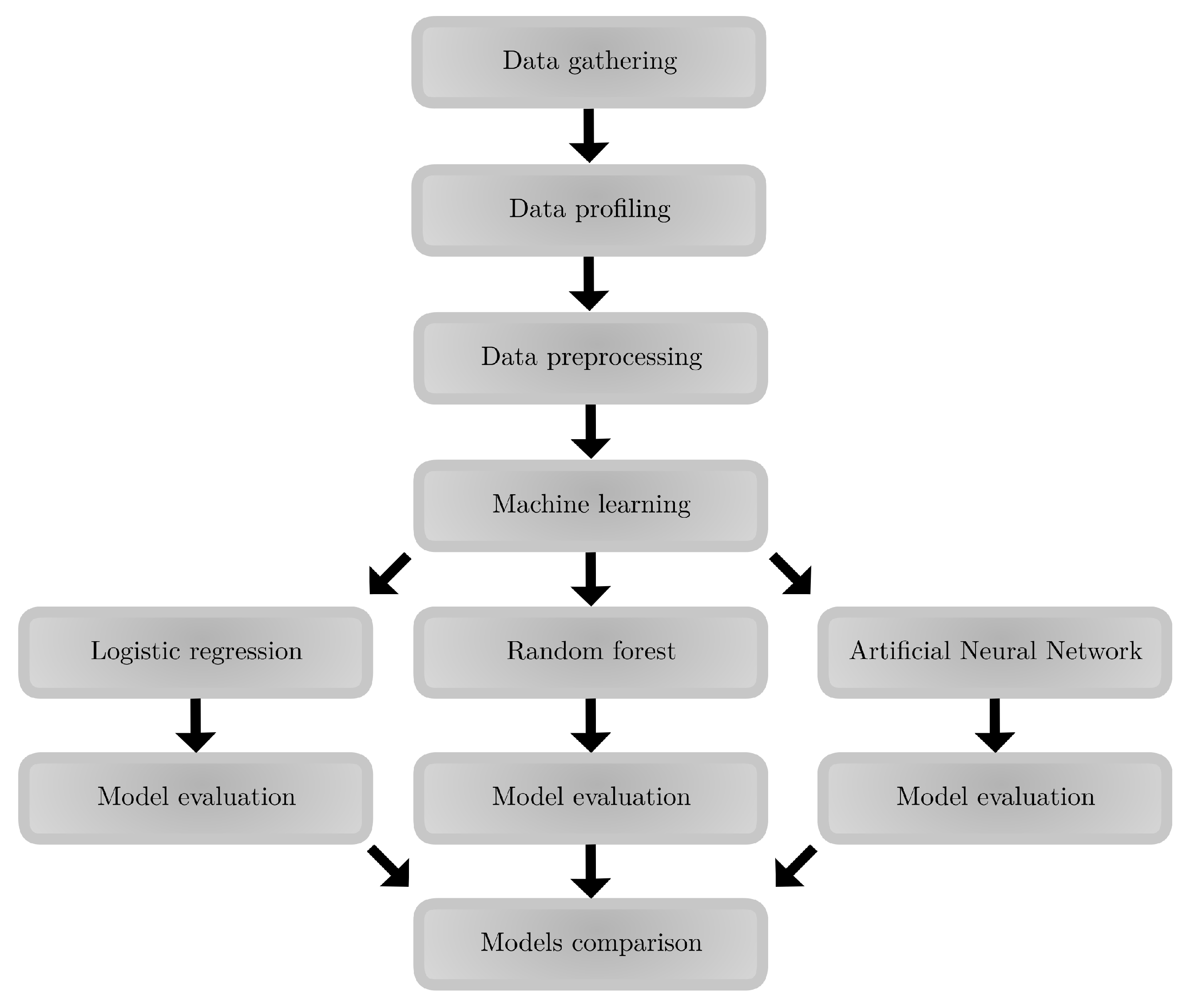

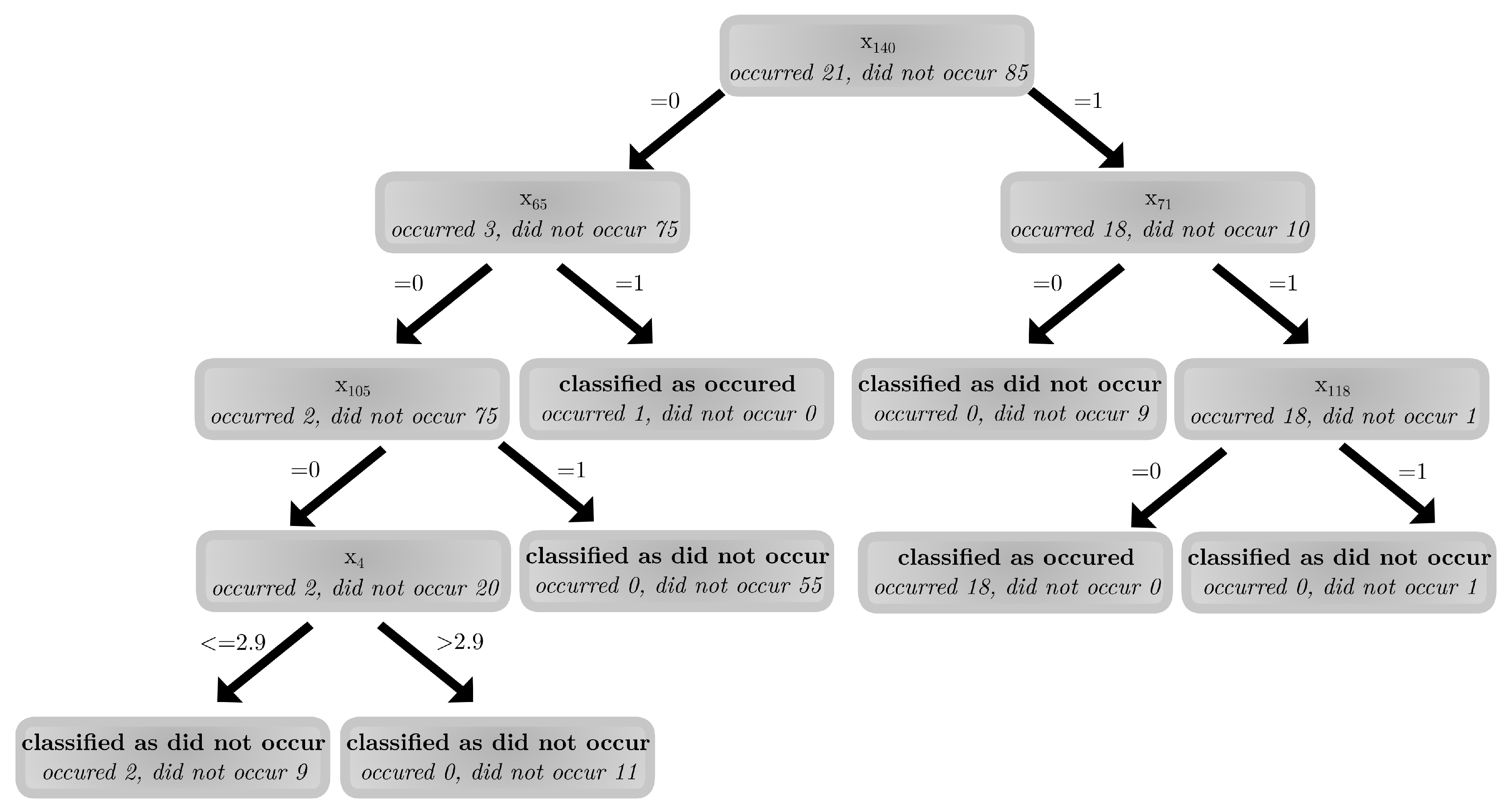
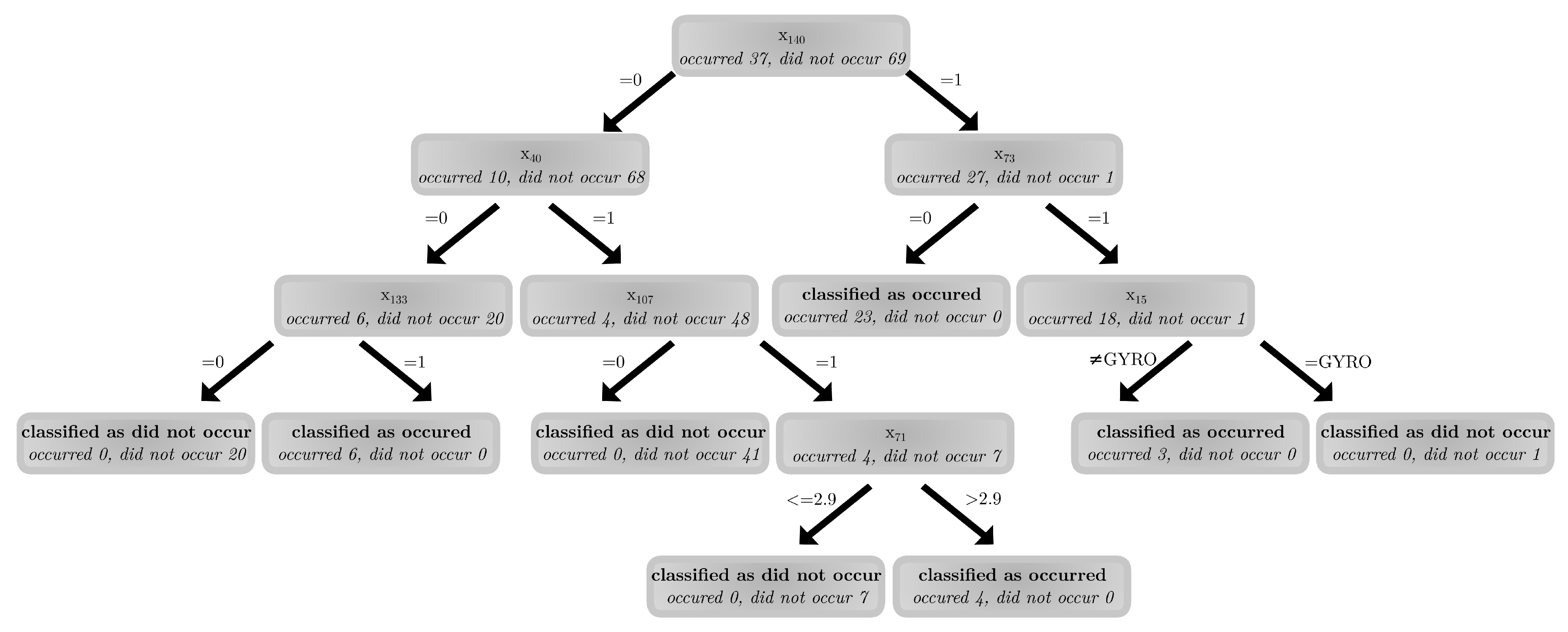
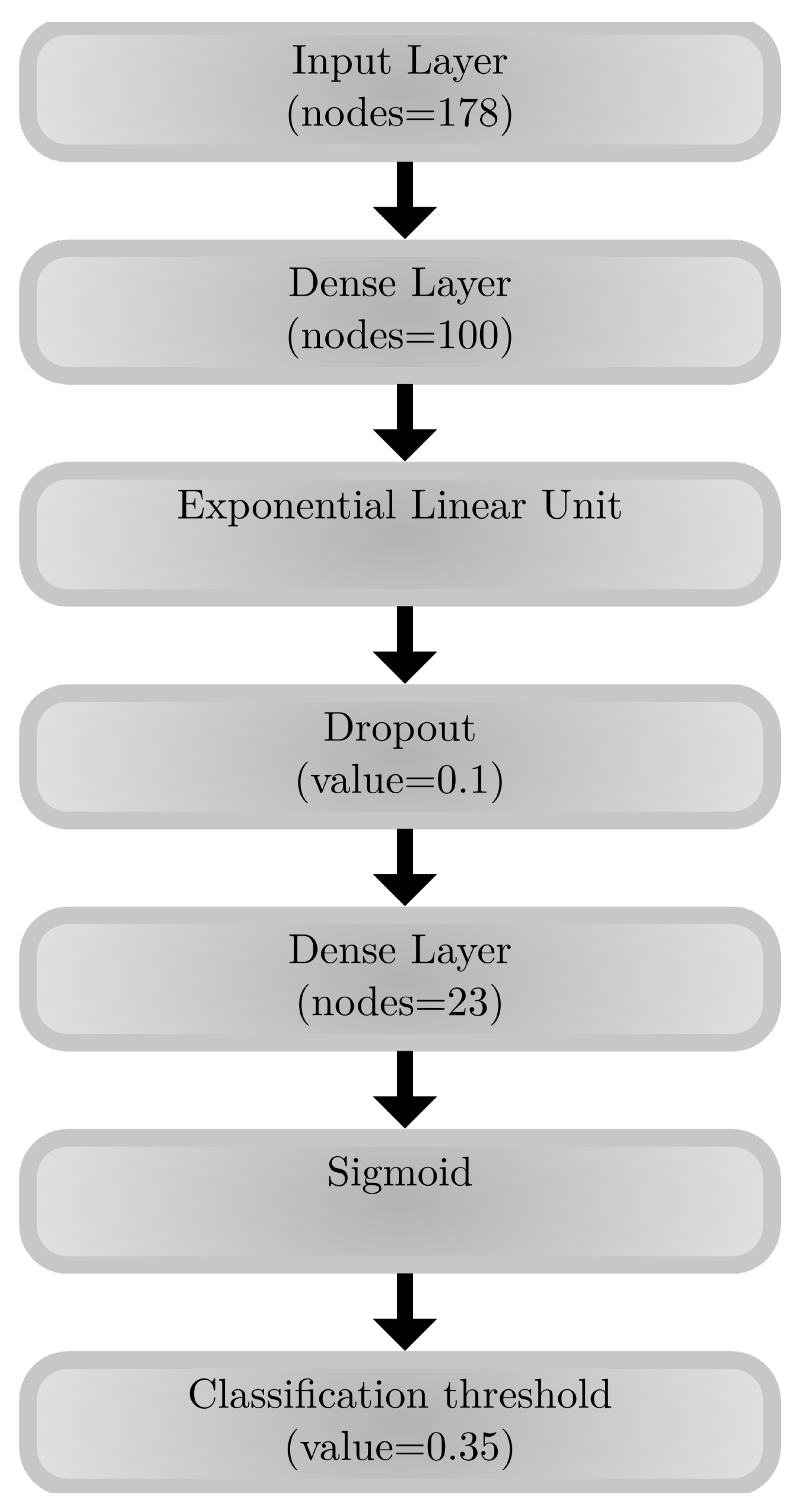

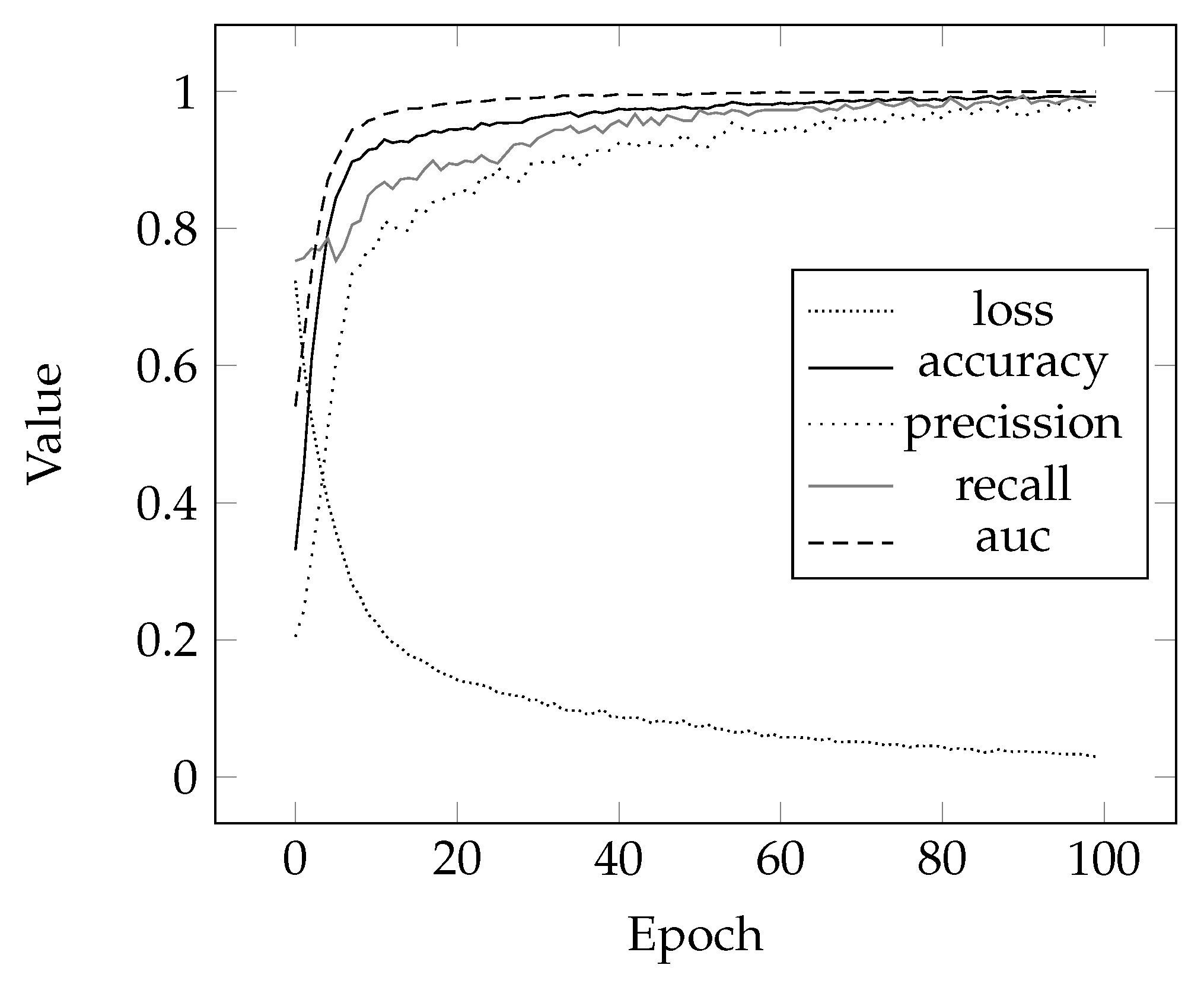
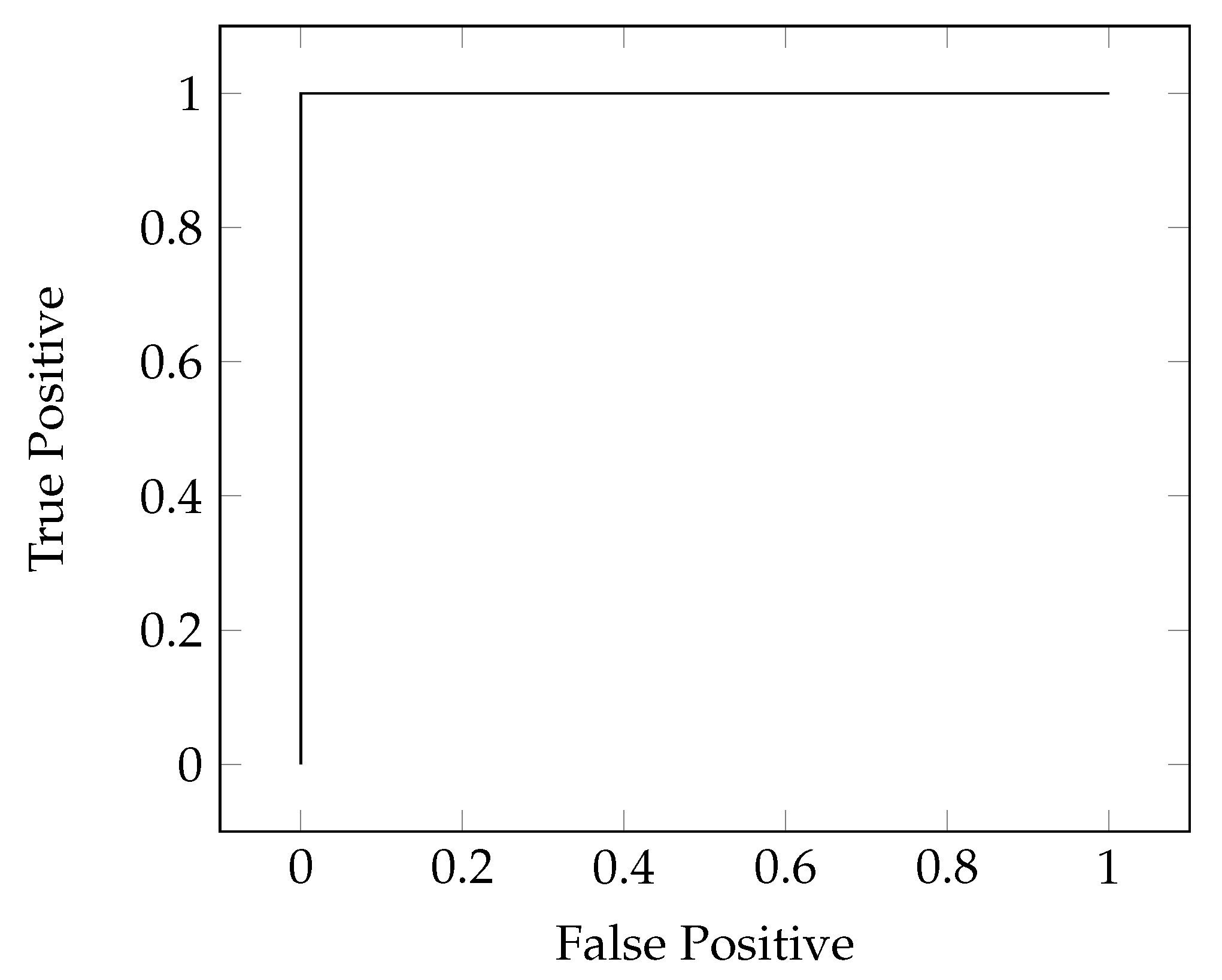
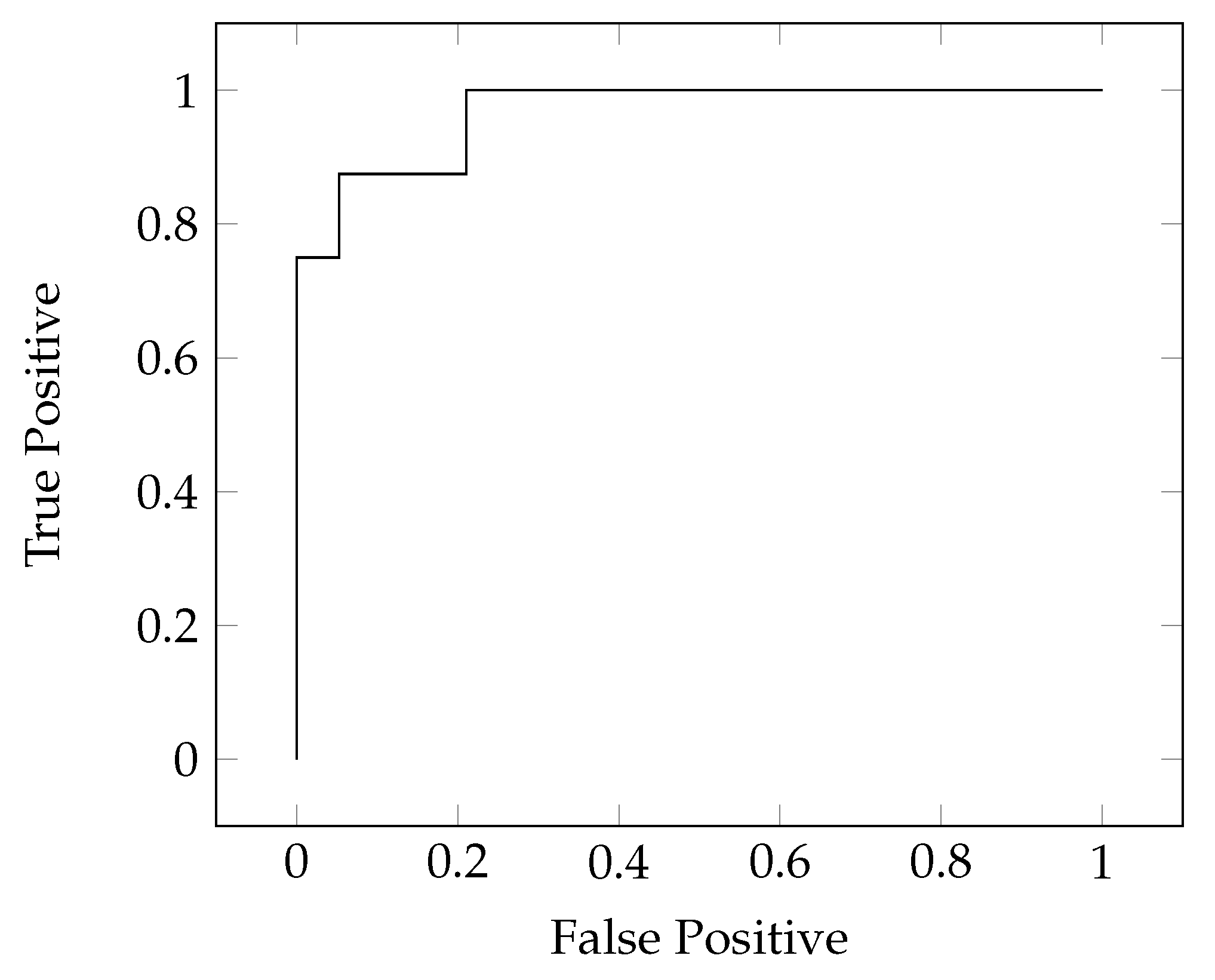
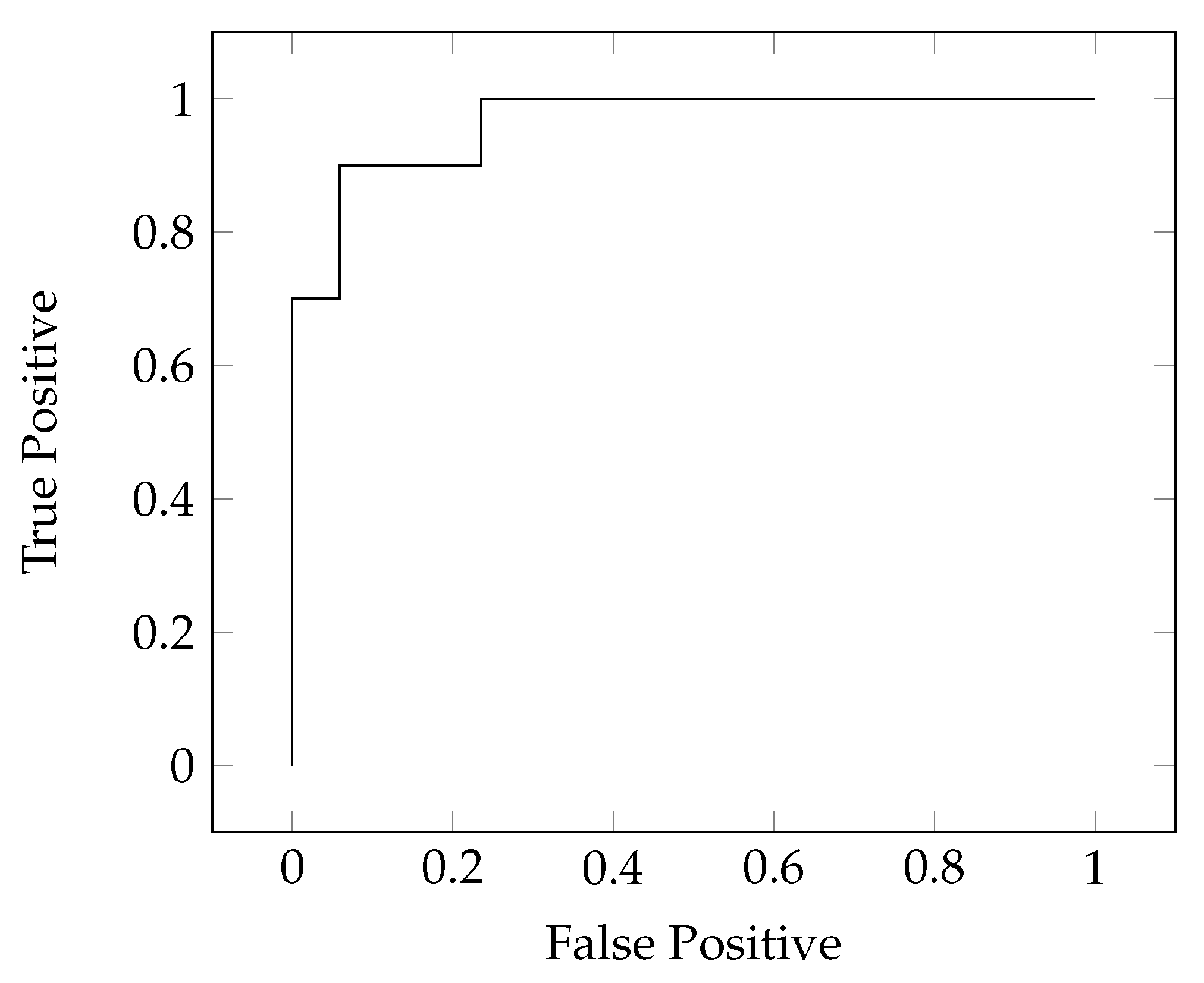
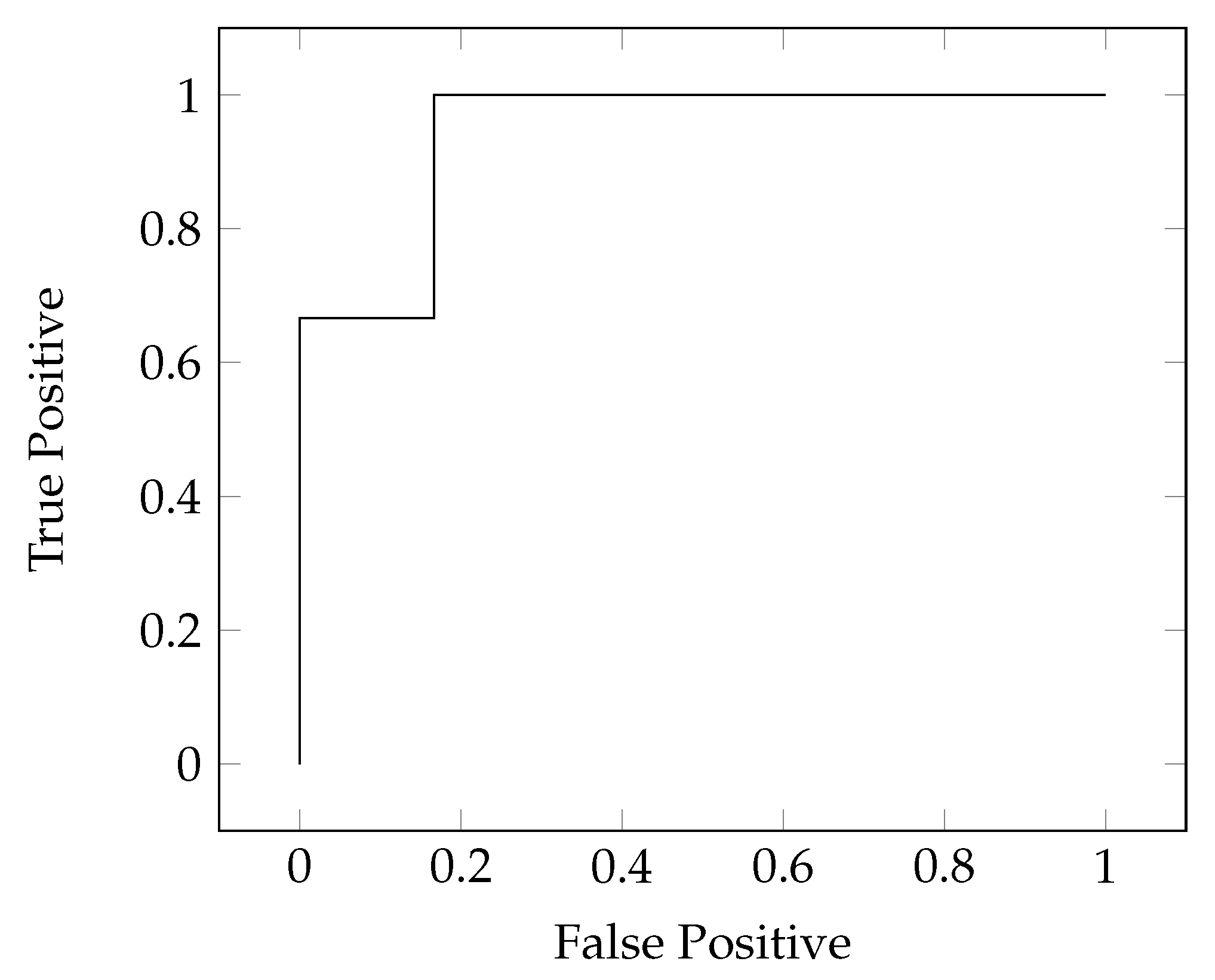
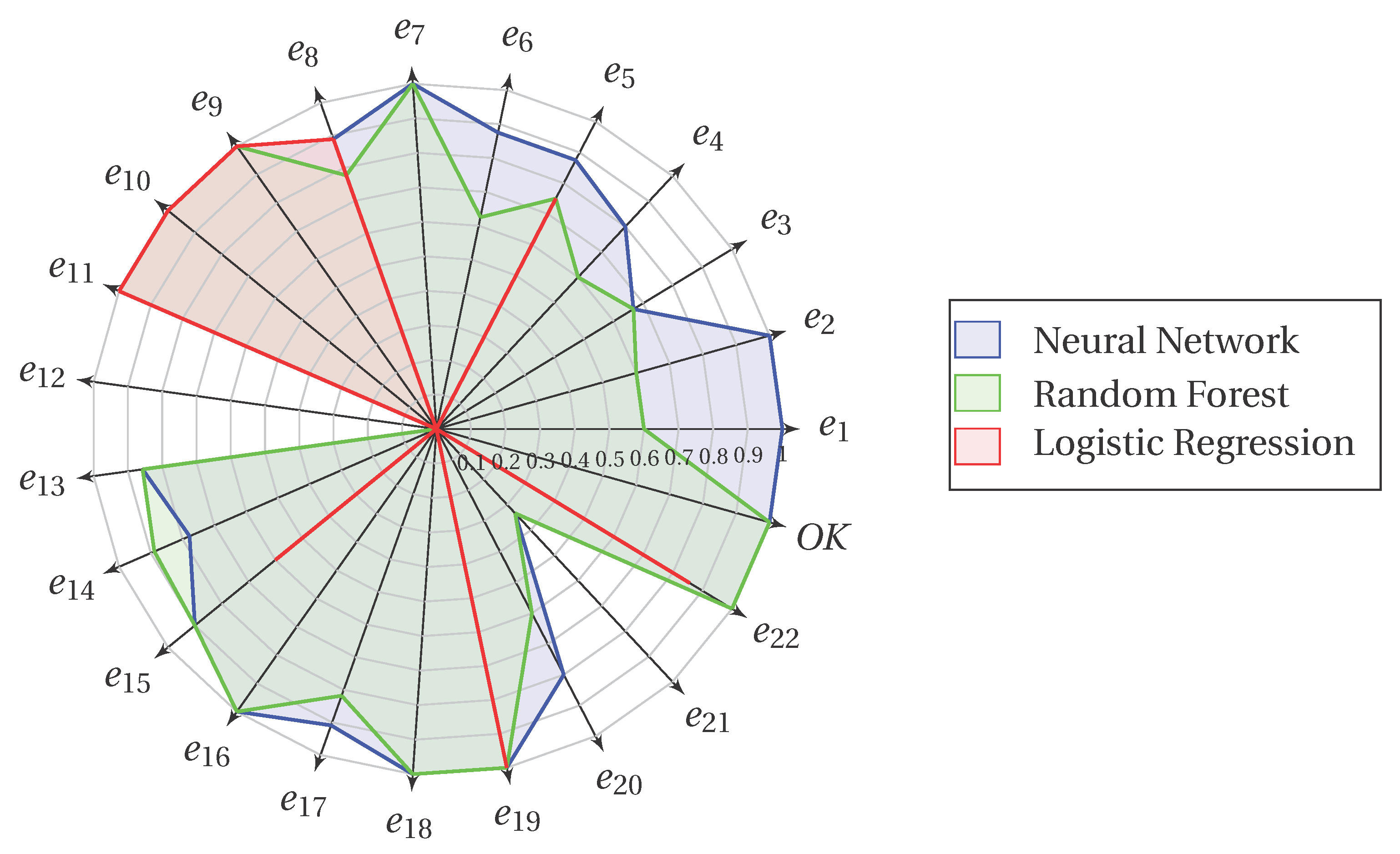
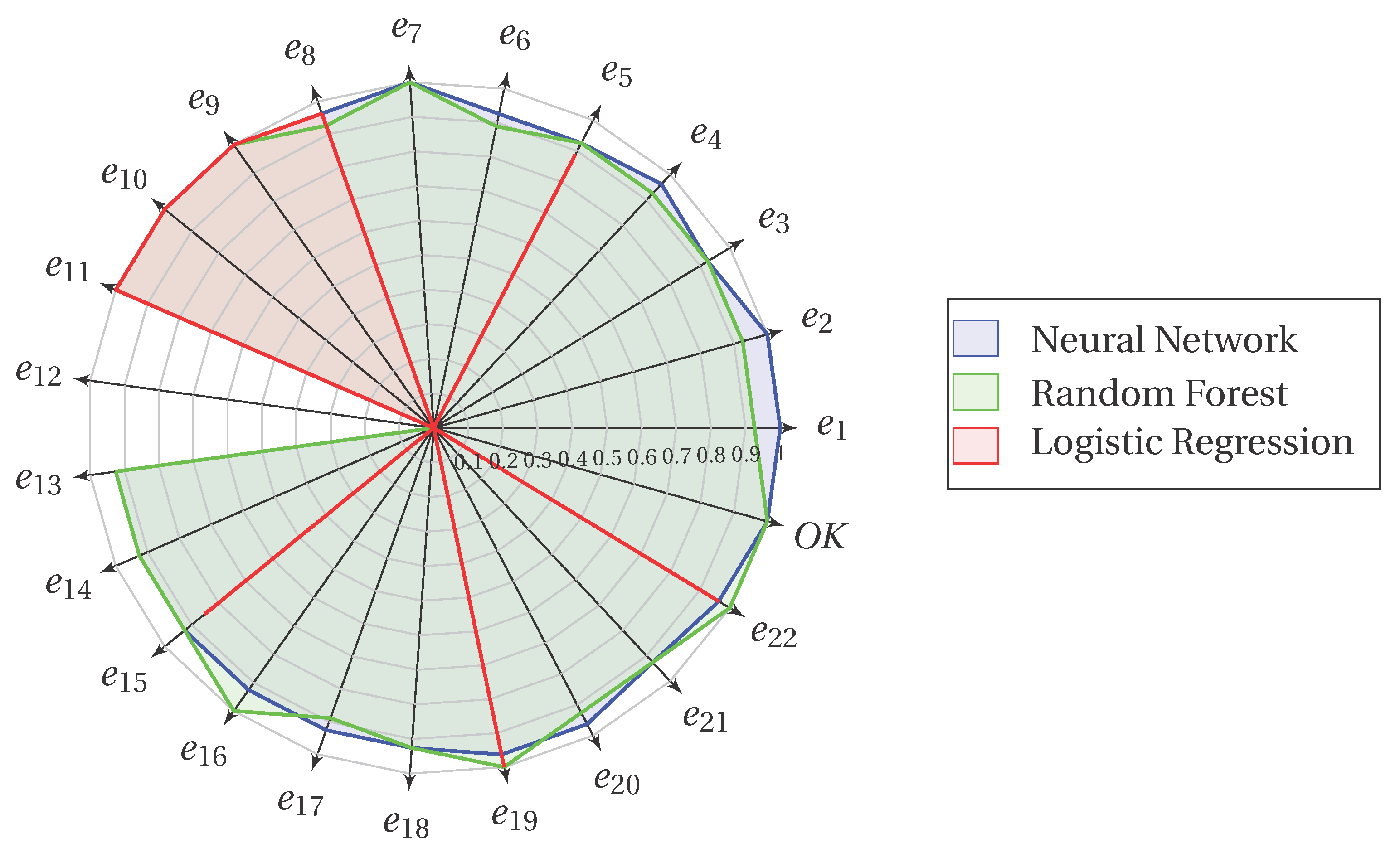


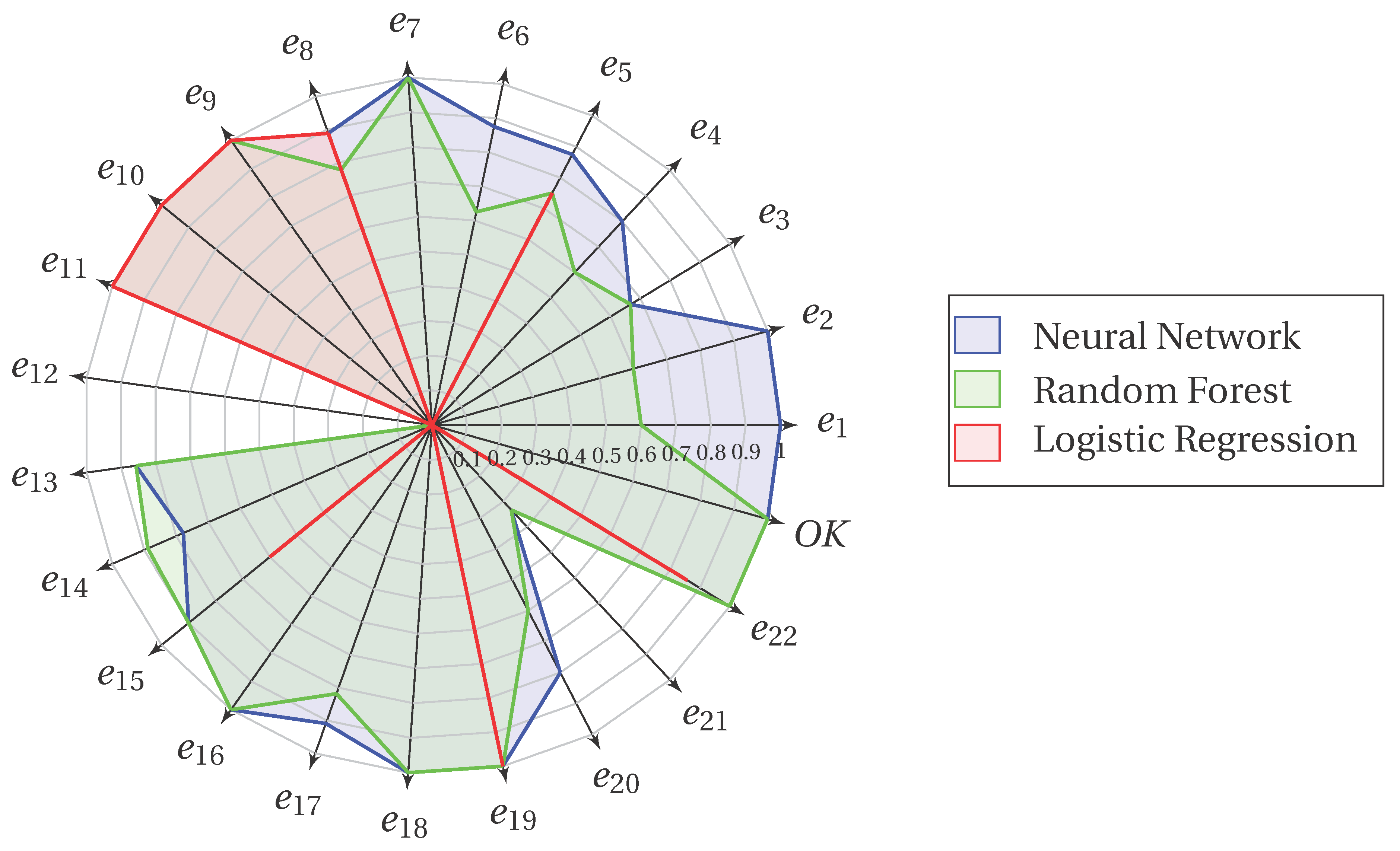
| Symbol | Unwanted Events |
|---|---|
| Incorrect calculations of loads and stresses for the installed pipeline | |
| Failure to consider the allowable bend–radius of drill pipes or the installed product pipe | |
| Incorrect choice of the external product pipe coating | |
| Problems with steering and communications with the drill rig | |
| Drill tool breakdown caused by the material’s fatigue | |
| Drill rig failure | |
| Mud motor failure | |
| Mud cleaning system failure | |
| Roller blocks breakdown | |
| Roller cradles breakdown | |
| Side cranes failure | |
| Ballasting system failure | |
| Downtime in the installation due to lack of required tools and machines | |
| Unexpected natural or anthropogenic underground obstacles | |
| Borehole collapse | |
| Swelling of the ground leading to the drilling pipe or product pipe blockage in the borehole | |
| Drilling fluid runoff | |
| Contractor’s mistake | |
| Quality or supply issues | |
| Problems with permissions or legal issues | |
| Unfavourable weather conditions | |
| Improper cost calculations for the project | |
| OK | The overall project result |
| Differentiating Factor | Parameters |
|---|---|
| Country | Poland, Mexico, Australia, Thailand, the Netherlands, Bulgaria, Saudi Arabia, Russia, Greece |
| Continents | Europe, Asia, Australia, South America |
| The type of the area | urban, post–industrial, rural, environmentally sensitive |
| Maximum depth | |
| Installation size | MINI (84), MIDI (9), MAXI (40) |
| Pipe diameter (mm) | 100–1400 mm |
| The total length (m) | 18–3048 m |
| Obstacle being crossed | river, channel, landfill, railway embankment, railroad tracks, water reservoir, street, highway, harbour floor, wetlands, sea, lack of obstacle |
| Pipe material | steel (105 installations), polyethylene (27 installations), flexwell (1 installation) |
| The type of installed utility | pressure sewer, gravity sewer, gas pipeline, oil pipeline, water pipeline, energy cables, telecommunications cables, fiber optic cables |
| Steering system | walkover (19), wireline (49), Optical Gyro (65) |
| Ground conditions | sands, clay, silt, bedrock, cobbles, boulders, gravels, anthropogenic land, etc. |
| Season | Spring, Summer, Autumn, Winter |
| Optional possibility of applying tools and machines | mud motor, mud leaning system, ballasting system, roller blocks, roller cradles, side cranes |
| No. of HDD Projects | Event | ||||||||||||||||||||||
|---|---|---|---|---|---|---|---|---|---|---|---|---|---|---|---|---|---|---|---|---|---|---|---|
| Did not occur (0) | 78 | 110 | 110 | 108 | 103 | 95 | 98 | 122 | 96 | 113 | 115 | 114 | 131 | 94 | 86 | 78 | 105 | 76 | 90 | 109 | 105 | 119 | 94 |
| Occurred (1) | 55 | 23 | 23 | 25 | 30 | 38 | 35 | 11 | 37 | 20 | 18 | 19 | 2 | 39 | 47 | 55 | 28 | 57 | 43 | 24 | 28 | 14 | 39 |
| Event Occurrence | |||
|---|---|---|---|
| True | False | ||
| Event predicted | True | True positive (TP) | False positive (FP) |
| False | False negative (FN) | True negative (TN) | |
| Dimension | Correlated Dimension | Parson’s Correlation Coefficient |
|---|---|---|
| (Sand layer with homogeneous grain size distribution) | 0.85 | |
| (Cheapest contractor chosen) | 0.95 | |
| 0.89 | ||
| (Project abroad) | 0.85 | |
| (Quality cable coating) | 0.86 | |
| (Tool repaired) | 0.94 | |
| (Positive previous experience with a supplier) | −0.86 | |
| 0.94 | ||
| 0.97 | ||
| (Tool repaired) | 1.0 | |
| (Previous positive experience with a supplier) | −0.91 | |
| (Materials quality certificate) | −0.87 | |
| 0.97 | ||
| (Tool repaired) | 0.97 | |
| (Previous positive experience with a supplier) | −0.88 | |
| 0.87 | ||
| (Sand layer with homogeneous grain size distribution) | 0.85 | |
| (Certified supplier) | −0.88 | |
| (Previous positive experience with a supplier) | −0.87 | |
| (Materials quality certificate) | −0.87 | |
| (Supervisor certified) | (Chief superintendent engineer certified) | 0.91 |
| (Mud motor certificate) | (Mud motor inspections) | 0.88 |
| (Mud motor certificate) | (New elastomeric elements) | 0.95 |
| (Mud motor OHS) | (Mud motor inspection) | 0.90 |
| (Risk level) | (No. of site investigation methods) | −0.94 |
| (Risk level) | (Proximity to existing utilities–acting as a drainage) | −0.88 |
| (Risk level) | (No. of shifts) | −0.91 |
| (Risk level) | (Season spring) | −0.87 |
| (Risk level) | (Season winter) | −0.87 |
| (Risk level) | (Drilling fluid additives against collapse) | −0.93 |
| (Risk level) | (Crossed obstacle) | −0.86 |
| (Risk level) | (Steering system type) | −0.89 |
| Event | Recall | Precision | Accuracy | AUC | |
|---|---|---|---|---|---|
| 0.750 | 0.857 | 0.889 | 0.800 | 0.849 | |
| 0.889 | 1.000 | 0.963 | 0.941 | 0.944 | |
| 1.000 | 1.000 | 1.000 | 1.000 | 1.000 | |
| 1.000 | 1.000 | 1.000 | 1.000 | 1.000 | |
| 1.000 | 1.000 | 1.000 | 1.000 | 1.000 | |
| 0.600 | 1.000 | 0.852 | 0.750 | 0.800 | |
| 1.000 | 1.000 | 1.000 | 1.000 | 1.000 | |
| 0.857 | 1.000 | 0.963 | 0.923 | 0.929 |
| Event | Recall | Precision | Accuracy | AUC | |
|---|---|---|---|---|---|
| 0.600 | 1.000 | 0.926 | 0.750 | 0.800 | |
| 0.600 | 1.000 | 0.926 | 0.750 | 0.800 | |
| 0.667 | 1.000 | 0.926 | 0.800 | 0.833 | |
| 0.600 | 1.000 | 0.926 | 0.750 | 0.800 | |
| 0.750 | 1.000 | 0.926 | 0.857 | 0.875 | |
| 0.625 | 1.000 | 0.889 | 0.769 | 0.813 | |
| 1.000 | 1.000 | 1.000 | 1.000 | 1.000 | |
| 0.778 | 1.000 | 0.926 | 0.875 | 0.889 | |
| 1.000 | 1.000 | 1.000 | 1.000 | 1.000 | |
| 1.000 | 1.000 | 1.000 | 1.000 | 1.000 | |
| 1.000 | 1.000 | 1.000 | 1.000 | 1.000 | |
| — | — | — | — | — | |
| 0.857 | 0.857 | 0.926 | 0.857 | 0.904 | |
| 0.889 | 0.889 | 0.926 | 0.889 | 0.917 | |
| 0.900 | 0.900 | 0.926 | 0.900 | 0.921 | |
| 1.000 | 1.000 | 1.000 | 1.000 | 1.000 | |
| 0.818 | 0.900 | 0.889 | 0.857 | 0.878 | |
| 1.000 | 0.778 | 0.926 | 0.875 | 0.950 | |
| 1.000 | 1.000 | 1.000 | 1.000 | 1.000 | |
| 0.600 | 1.000 | 0.926 | 0.750 | 0.800 | |
| 0.333 | 1.000 | 0.926 | 0.500 | 0.667 | |
| 1.000 | 1.000 | 1.000 | 1.000 | 1.000 | |
| 1.000 | 1.000 | 1.000 | 1.000 | 1.000 |
| Event | |||||
|---|---|---|---|---|---|
| 1.000 | 1.000 | 1.000 | 1.000 | 1.000 | |
| 1.000 | 1.000 | 1.000 | 1.000 | 1.000 | |
| 0.667 | 1.000 | 0.926 | 0.800 | 1.000 | |
| 0.800 | 1.000 | 0.963 | 0.889 | 0.982 | |
| 0.875 | 0.875 | 0.926 | 0.875 | 0.967 | |
| 0.875 | 0.875 | 0.926 | 0.875 | 0.980 | |
| 1.000 | 1.000 | 1.000 | 1.000 | 1.000 | |
| 0.889 | 1.000 | 0.963 | 0.941 | 1.000 | |
| 1.000 | 1.000 | 1.000 | 1.000 | 1.000 | |
| 1.000 | 1.000 | 1.000 | 1.000 | 1.000 | |
| 1.000 | 1.000 | 1.000 | 1.000 | 1.000 | |
| — | — | — | — | — | |
| 0.857 | 0.857 | 0.926 | 0.857 | 0.971 | |
| 0.778 | 1.000 | 0.926 | 0.875 | 0.975 | |
| 0.900 | 0.900 | 0.926 | 0.900 | 0.965 | |
| 1.000 | 0.667 | 0.926 | 0.800 | 1.000 | |
| 0.909 | 0.909 | 0.926 | 0.909 | 0.994 | |
| 1.000 | 0.778 | 0.926 | 0.875 | 0.993 | |
| 1.000 | 0.800 | 0.963 | 0.889 | 1.000 | |
| 0.800 | 1.000 | 0.963 | 0.889 | 0.982 | |
| 0.333 | 1.000 | 0.926 | 0.500 | 0.944 | |
| 1.000 | 0.875 | 0.963 | 0.933 | 0.993 | |
| 1.000 | 1.000 | 1.000 | 1.000 | 1.000 |
Publisher’s Note: MDPI stays neutral with regard to jurisdictional claims in published maps and institutional affiliations. |
© 2021 by the authors. Licensee MDPI, Basel, Switzerland. This article is an open access article distributed under the terms and conditions of the Creative Commons Attribution (CC BY) license (http://creativecommons.org/licenses/by/4.0/).
Share and Cite
Krechowicz, M.; Krechowicz, A. Risk Assessment in Energy Infrastructure Installations by Horizontal Directional Drilling Using Machine Learning. Energies 2021, 14, 289. https://doi.org/10.3390/en14020289
Krechowicz M, Krechowicz A. Risk Assessment in Energy Infrastructure Installations by Horizontal Directional Drilling Using Machine Learning. Energies. 2021; 14(2):289. https://doi.org/10.3390/en14020289
Chicago/Turabian StyleKrechowicz, Maria, and Adam Krechowicz. 2021. "Risk Assessment in Energy Infrastructure Installations by Horizontal Directional Drilling Using Machine Learning" Energies 14, no. 2: 289. https://doi.org/10.3390/en14020289
APA StyleKrechowicz, M., & Krechowicz, A. (2021). Risk Assessment in Energy Infrastructure Installations by Horizontal Directional Drilling Using Machine Learning. Energies, 14(2), 289. https://doi.org/10.3390/en14020289






